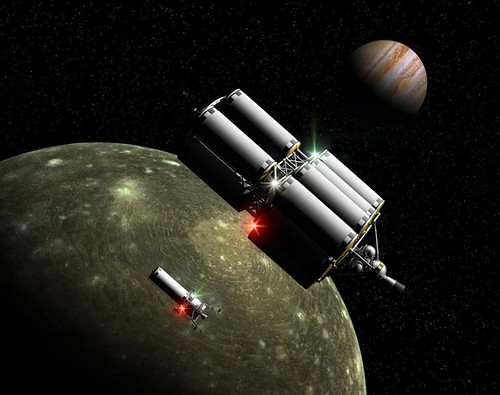Atomic Rockets
Atomic Rockets may be the ultimate space geek playground. It's chock full of design data for all kinds of spacecraft -- real, imagined and fantastic. For example, this is a concept for a lighter and tanker supporting a proposed hydrogen generation plant on Callisto:

Designed in 1975, it utilizes a gas-core nuclear thermal rocket, which makes chemical rockets look like cheap fireworks. The idea is to set up a refinery on Callisto, which is about half ice water, and convert it to hydrogen fuel, which could then be lifted to the tanker and distributed where needed -- colonies in the Asteroid Belt, Lagrange point refueling stations, orbital transfer stations at Mars or Earth, etc -- without the expense of having to boost all that mass out of a large planetary gravity well. The high specific impulse of the engine means that it could utilize huge amounts of delta-v to maneuver rapidly throughout the inner solar system with minimal use of Hohmann transfers. In other words, it could "keep the pumps full" for slower, more conventional ships which utilize more economical, less energy-hungry methods of moving about the system. Fascinating concept.
As I said, the site is a treasure trove, with all the math, design details, and other tasty grist for your engineering mill you could ever desire. If this is your thing, put the kids to bed, sit down with a glass (or bottle) of your favored libation, and prepare to be lost for many hours.
If you're not content, however, to merely read about the designs of others, you can always attempt to build and fly your own in Kerbal Space Program. I've never experienced a thrill quite like the first time I managed to achieve a stable orbit (after much failed experimentation). Don't laugh; it's harder than you think. While basic orbital mechanics aren't terribly difficult to understand, the application isn't as simple as it first seems. I'm still working on my Moon mission, so Juclip refineries (that's geekspeak for the Jupiter ecliptic -- i.e., the Jupiter moon system) and interplanetary refueling stations are still a distant dream... but someday. WARNING! HIGHLY ADDICTIVE.

Designed in 1975, it utilizes a gas-core nuclear thermal rocket, which makes chemical rockets look like cheap fireworks. The idea is to set up a refinery on Callisto, which is about half ice water, and convert it to hydrogen fuel, which could then be lifted to the tanker and distributed where needed -- colonies in the Asteroid Belt, Lagrange point refueling stations, orbital transfer stations at Mars or Earth, etc -- without the expense of having to boost all that mass out of a large planetary gravity well. The high specific impulse of the engine means that it could utilize huge amounts of delta-v to maneuver rapidly throughout the inner solar system with minimal use of Hohmann transfers. In other words, it could "keep the pumps full" for slower, more conventional ships which utilize more economical, less energy-hungry methods of moving about the system. Fascinating concept.
As I said, the site is a treasure trove, with all the math, design details, and other tasty grist for your engineering mill you could ever desire. If this is your thing, put the kids to bed, sit down with a glass (or bottle) of your favored libation, and prepare to be lost for many hours.
If you're not content, however, to merely read about the designs of others, you can always attempt to build and fly your own in Kerbal Space Program. I've never experienced a thrill quite like the first time I managed to achieve a stable orbit (after much failed experimentation). Don't laugh; it's harder than you think. While basic orbital mechanics aren't terribly difficult to understand, the application isn't as simple as it first seems. I'm still working on my Moon mission, so Juclip refineries (that's geekspeak for the Jupiter ecliptic -- i.e., the Jupiter moon system) and interplanetary refueling stations are still a distant dream... but someday. WARNING! HIGHLY ADDICTIVE.

0 Comments:
Post a Comment
<< Home